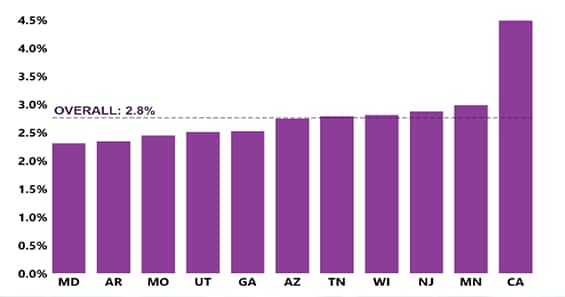Key Findings from the ADDM Network
‹View Table of Contents
Download and print this page [PDF – 1.26 MB]
A Snapshot of Autism Spectrum Disorder in 2020
Children age 4 were 1.6 times
as likely as children age 8 to be identified as having ASD by 48 months.

Data from the Autism and Developmental Disabilities Monitoring (ADDM) Network helps us understand more about the number of children with autism spectrum disorder (ASD), the characteristics of those children, and the age at which they are first evaluated and diagnosed. Read on to learn more about ASD in communities.
There have been improvements in early ASD identification over time.
More children who were born in 2016 (1.8%) received an ASD diagnosis or special education classification by 4 years of age compared with children born in 2012 (1.1%), suggesting progress in early ASD identification over time.
In 2020, children born in 2016 (4-year-olds) were 1.6 times as likely as children born in 2012 (8-year-olds) to be identified as having ASD by 48 months of age.
From 2016 to the beginning of 2020, 4-year-old children had more evaluations and identifications than children aged 8-years (when they were 4) had from 2012 through 2016.

Displayed as 6 months prior and 6 months post-pandemic
The COVID-19 pandemic impacted early ASD identification.
Prior to the start of the COVID-19 pandemic, 4-year-old children were receiving more evaluations and identifications than 8-year-old children did when they were 4 years of age.
Prior to the start of the COVID-19 pandemic, 4-year-old children were receiving more evaluations and identifications than 8-year-old children did when they were 4 years of age. However, around the start of the COVID-19 pandemic in March 2020, the rate of evaluation and ASD identification decreased dramatically among 4-year-old children compared with 8-year-old children when they were 4 years of age. Evaluations and ASD identification did not return to pre-pandemic levels through the end of 2020. Moving forward, it will be important to identify ways to support children who have experienced delays in early ASD identification and to improve equitable and timely access to early identification.
1 in 36
8-year-old children identified
with ASD in 2020
*Based on tracking within 11 communities in the United States
How many 8-year-old children were identified with ASD in 2020?
About 1 in 36 (2.8%) 8-year-old children were identified with ASD by the ADDM Network.
Percent of 8-year-old children identified with ASD by ADDM Network Sites

For every girl identified with ASD, boys were nearly 4 times as likely to be identified

The percentage of children identified with ASD varied across geographic areas in 2020.
Across the ADDM Network, the percentage of 8-year-old children who were identified with ASD ranged from 2.3% or 1 in 43 children in Maryland to 4.5% or 1 in 22 children in California. The ADDM Network monitored ASD at the same sites in 2018 and 2020, but some sites improved data access with education records available for the first times.
Black, Hispanic and Asian or Pacific Islander children were more likely to be identified with ASD than White children for the first time in ADDM.

Values indicate prevalence per 1,000 children
Certain children were more likely to be identified with ASD.
Among 8-year-old children, boys were nearly 4 times as likely as girls to be identified with ASD.
However, 2020 marked the first time the ADDM Network found the percentage of girls identified with ASD to be over 1%.
Also in 2020, Black, Hispanic, and Asian or Pacific Islander children had a higher percentage of ASD than White children for the first time among 8-year-olds.
Among 8-year-old children identified with ASD who had intelligence quotient (IQ) scores available, more than one-third (37.9%) also had intellectual disability.
Approximately 1/3 Of children with ASD also had intellectual disability

Pages in this Report
- 2023 Community Report on Autism
- Executive Summary
- ›Key Findings from the ADDM Network
- A Deeper Dive
- Spotlight On: Progress in Early Identification Disrupted during the COVID-19 Pandemic
- Spotlight On: A New Pattern in Racial and Ethnic Differences
- Data for Action
- ADDM Network Site Snapshots Overview
- A Snapshot of Autism Spectrum Disorder in Arizona
- A Snapshot of Autism Spectrum Disorder in Arkansas
- A Snapshot of Autism Spectrum Disorder in California
- A Snapshot of Autism Spectrum Disorder in Georgia
- A Snapshot of Autism Spectrum Disorder in Maryland
- A Snapshot of Autism Spectrum Disorder in Minnesota
- A Snapshot of Autism Spectrum Disorder in Missouri
- A Snapshot of Autism Spectrum Disorder in New Jersey
- A Snapshot of Autism Spectrum Disorder in Tennessee
- A Snapshot of Autism Spectrum Disorder in Utah
- A Snapshot of Autism Spectrum Disorder in Wisconsin
- Glossary
- References